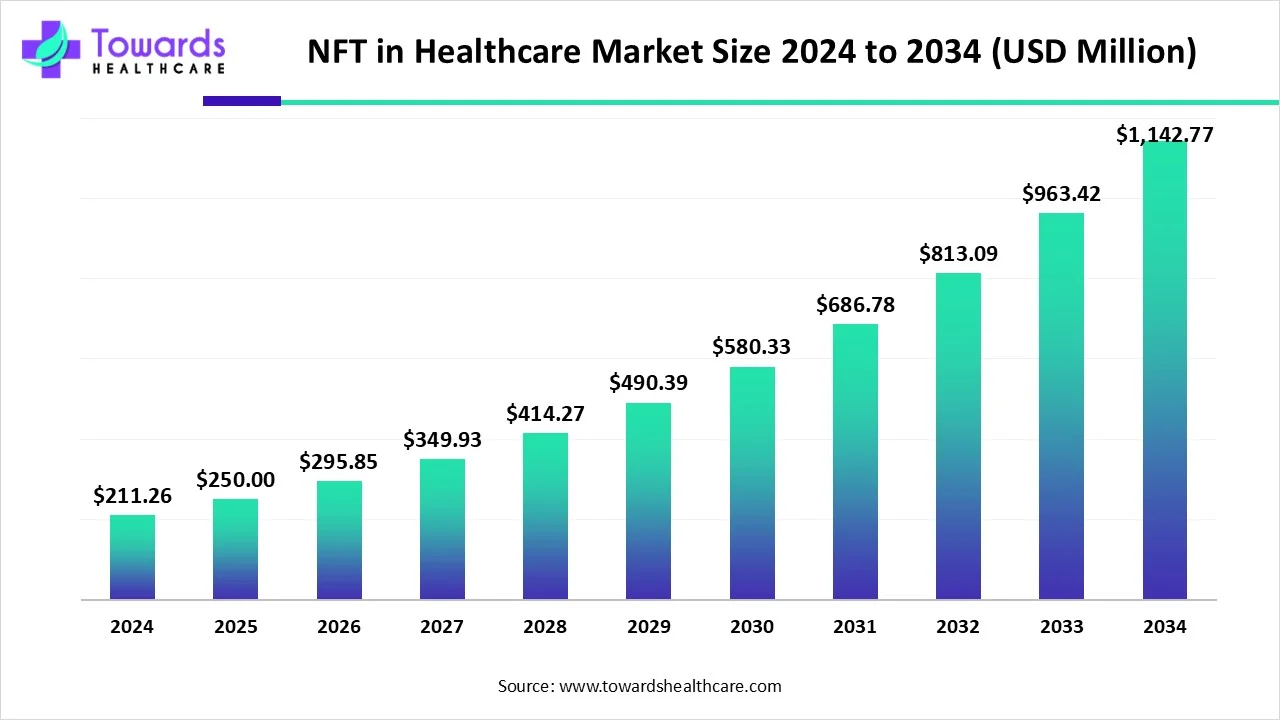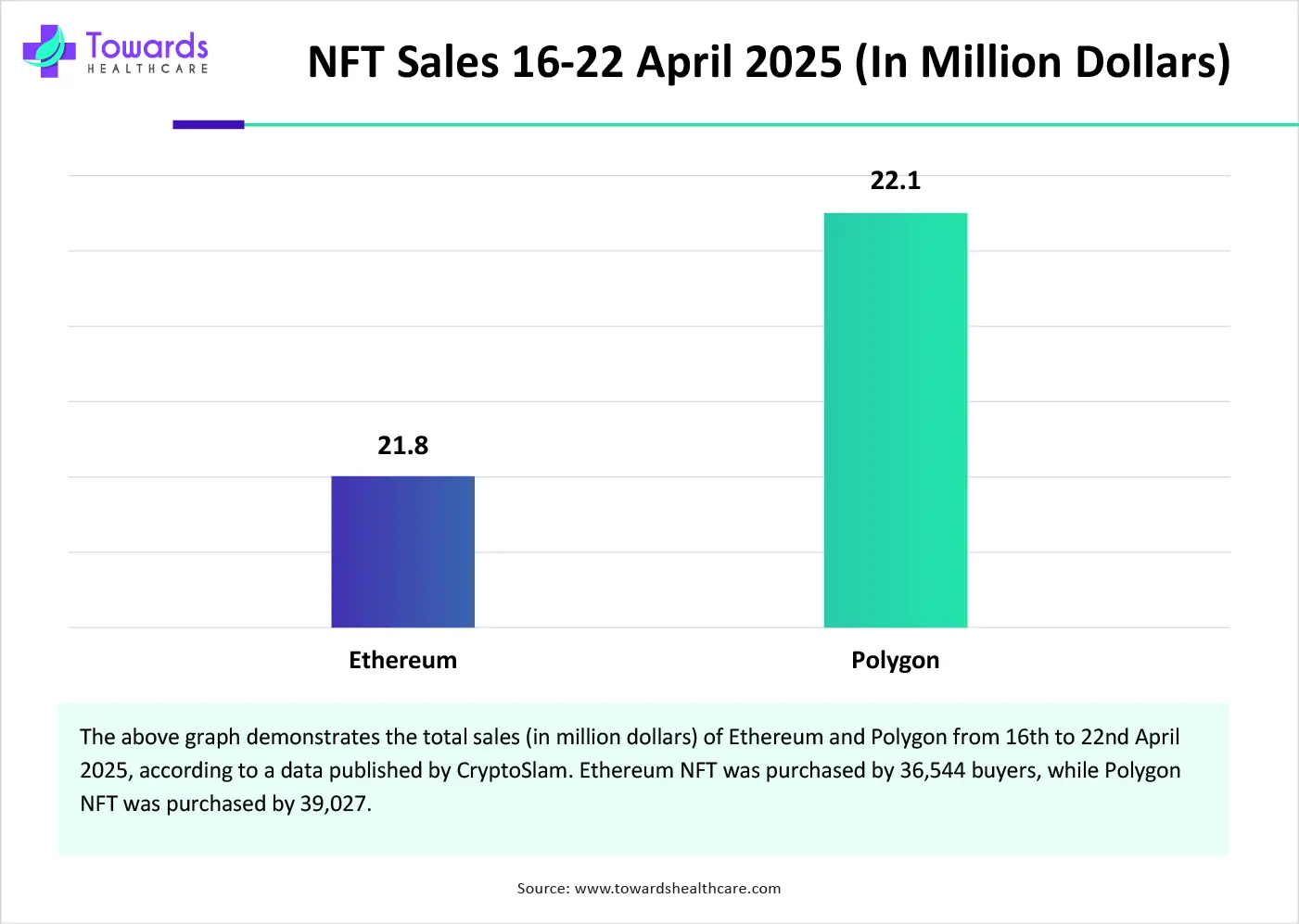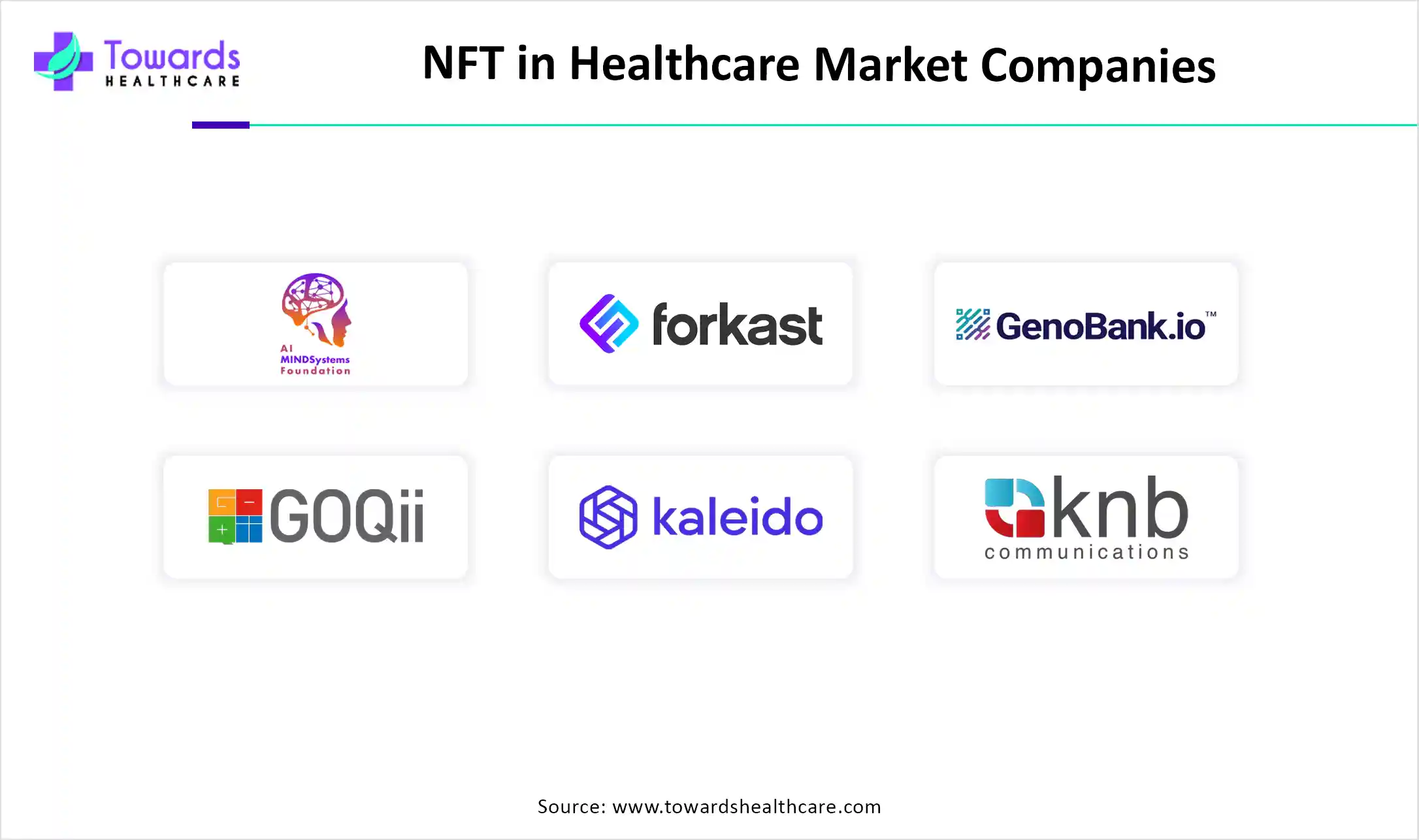November 2025

The global NFT in healthcare market size is calculated at USD 211.26 million in 2024, grew to USD 250 million in 2025, and is projected to reach around USD 1142.77 million by 2034. The market is expanding at a CAGR of 18.34% between 2025 and 2034.

| Metric | Details |
| Market Size in 2024 | USD 211.26 Million |
| Projected Market Size in 2034 | USD 1142.77 Million |
| CAGR (2025 - 2034) | 18.34% |
| Leading Region | North America |
| Market Segmentation | By Blockchain, By Application, By End-User, By Region |
| Top Key Players |
AI MINDSystems Foundation, ChainCode Consulting LLP, ForkastLabs, GenoBank.io, GOQii, GYMetaverse, Kaleido, KNB Communications, PixelPlex, QSS Technosoft, SnowSeed |
Non-fungible tokens (NFTs) are cryptographic assets recorded on the blockchain to certify authenticity and ownership. NFTs have garnered remarkable attention in various industrial and scientific fields, including healthcare. They have been found to combat counterfeiting of medical devices and facilitate supply chain management, electronic health records, or digital twins. They can be used to monetize health data, optimize stem cell transplant procedures, and improve the distribution of solid organs for transplant.
The rising need for effective supply chain management due to stringent regulatory frameworks paves the way for NFTs in healthcare. The increasing number of new product launches necessitates that companies maintain an effective supply chain. The growing demand for stem cell transplants and rising organ transplantations boost the market. The advent of advanced technologies, such as NFT and blockchain technology has revolutionized the healthcare sector.
Artificial intelligence (AI) can synergize the benefits of NFTs in healthcare. Integrating AI in NFTs can enhance functionality, value, and user experience. This transforms the way digital assets are created, traded, perceived, and utilized by users. AI can analyze patient preferences and suggest NFTs based on their requirements. It can also be used to identify counterfeit NFTs and verify the authenticity of digital assets. AI and machine learning (ML) algorithms can analyze a patient’s health information, enabling them to make effective health decisions. AI integration in NFTs can also enable the assessment of the worth of digital assets.
Demand for Patient-Centric Care
The major growth of the NFT in healthcare market is the growing demand for patient-centric care. Patient-centric care refers to treating patients with dignity and involving them in all health-related decisions. Patient has complete control over their healthcare data and access to share their personal health information. It is essential as it improves patient satisfaction and overall treatment outcomes. This has led to the rising adoption of advanced solutions, such as electronic health records (EHRs). Blockchain-enabled NFTs enable patients to digitally represent things like credentials, reputation, and records of medical care that cannot be purchased. They allow patients to manage personal information without storing it in a central database. According to a recent systematic review article published by the University of Johannesburg researchers, 14 out of 19 papers addressed the use of NFTs from a patient-centric data management perspective.
Absence of Evidence
The major challenge of the NFT in healthcare market is the absence of robust evidence. NFTs in healthcare are still in their infancy. This makes it challenging to justify investments in digital health technologies and to convince stakeholders of their value. It is also difficult to evaluate the effectiveness, safety, and quality of such systems.
Digital Twin
The future of the market is promising, driven by the increasing use of digital twins in the healthcare sector. A digital twin is a digital replica of a physical object that takes inputs to produce outputs. The modifications made in a digital twin can be applied to the physical object. Digital twin technology is an emerging technology and offers tremendous opportunities for personalized healthcare, predictive interventions, remote monitoring, and medical research advancements. NFTs can be used to create digital twins, providing a transparent, robust platform for decentralized storage. Additionally, NFTs can represent medical devices as digital twins, capturing their attributes and metadata throughout their lifecycle, from production to ownership.
By blockchain, the Ethereum segment held a dominant presence in the NFT in healthcare market in 2024. Ethereum is the most widely used decentralized platform of blockchain that introduced smart contracts. Smart contracts allow users to make transactions without a central authority. They were developed to allow the dynamic addition of new features and business rules in domains outside of finance. The lifecycle of Ethereum smart contracts consists of four stages: creation, deployment, execution, and completion. All these processes can be completed without any third-party.
By blockchain, the polygon segment is estimated to show a notable growth in the NFT in healthcare market over the coming years. The demand for Polygon NFTs is increasing, owing to their scalability and affordability. It can handle large volumes of transactions, reducing congestion and enhancing speed. It enables faster and cheaper transactions and offers the reliability of Ethereum. Additionally, Polygon is compatible with Ethereum, allowing users the benefits of both platforms.

By application, the health records management segment led the global NFT in healthcare market in 2024. The growing demand for preventive healthcare and the need for early disease detection boost the segment’s growth. This potentiates the use of electronic health records (EHRs) and wearable devices, leading to an increase in patient health records. According to a recent study, 1 in 3 Americans use wearable devices. NFTs help patients to have complete control over their sensitive health information without storing it on a central database.
By application, the clinical trial consent segment is anticipated to grow with the highest CAGR in the market during the studied years. The increasing number of clinical trials and growing research and development activities augment the segment’s growth. As of April 2025, there are around 20,812 active clinical trials registered on the clinicaltrials.gov website. NFTs play a vital role in tracking and monitoring consent agreements of participants in real-time, as well as tracking transactions.
By end-user, the healthcare professionals segment held the largest share of the NFT in healthcare market in 2024. NFTs are essential for healthcare professionals in the secure and transparent management of patient data, facilitating access to health records. Healthcare professionals face significant challenges regarding patient health information privacy and security. NFTs enable automated and efficient data management, minimizing the risk of errors and miscommunication. The growing demand for remote monitoring and healthcare apps potentiates the use of NFTs.
By end-user, the pharmaceutical companies segment is projected to expand rapidly in the market in the coming years. Pharmaceutical companies develop novel drugs and medical devices to expand their product pipeline. This requires them to supply their products effectively at various geographical locations. NFTs help pharmaceutical companies manage their supply chain by tracking every step of delivery. They also provide certificates of ownership for drugs and medical devices, reducing counterfeiting of pharmaceutical products.
North America dominated the global NFT in healthcare market in 2024. The rising adoption of advanced technologies and increasing investments drive the market. North American people are more aware of blockchain technology and its benefits. Several government organizations support the development and use of NFTs in the healthcare sector. Advanced healthcare infrastructure and increasing collaborations among industry players also contribute to market growth.
The United States Patent and Trademark Office (USPTO) regulates trademarks on advanced technologies, such as NFTs, blockchain, cryptocurrency, and virtual goods. In May 2024, the U.S. Department of the Treasury published a 2024 Non-Fungible Token (NFT) Illicit Finance Risk Assessment report, providing information on how NFTs can be exploited for money laundering, terrorist financing, and proliferation financing. The report also mentioned the mitigation solutions for such risks.
The increasing use of wearable devices raises the demand for NFTs. Around 40% of Canadians use wearable technology, out of which around 28% are consistent. It is estimated that around 61% of Canadians who use wearable devices wish to share their data with healthcare providers.
Asia-Pacific is projected to host the fastest-growing NFT market in the healthcare market in the coming years. The rising prevalence of chronic disorders leads to rising stem cell transplants and organ donations. The growing awareness of NFTs and their benefits in healthcare is likely to dominate the market in Asia-Pacific. The increasing healthcare expenditure and growing research and development activities foster market growth. Asia-Pacific countries have favorable manufacturing facilities, encouraging foreign investors to set up their manufacturing plants. This increases the demand for NFTs to manage the supply chain globally.
Japan’s new Prime Minister, Shigeru Ishiba, announced his commitment to pro-blockchain and NFT policies. This move aims to leverage blockchain technology to enhance regional economies by adding value to local products. Japan’s NFT revenue grew to $631.1 million between 2020 and 2023. It is estimated to reach $6 billion by 2030.
The Australian government legally regulates NFTs within the existing framework of financial services. Australia has an emerging blockchain technology industry and a relatively sophisticated crypto ecosystem. The Australian government also supports digital health research by investing $20 million to commercialize these projects.
Europe is expected to grow at a notable rate in the NFT in healthcare market in the foreseeable future. Favorable government initiatives support digital healthcare in Europe. The European government aims to publish new rules to regulate NFTs. The Markets in Crypto-Assets (MiCA) Regulation focuses on bringing uniformity and consistency to the regulation of crypto-assets across all EU member states. The burgeoning healthcare sector and the growing demand for patient-centric care promote the market.
The Federal Ministry of Health has established the necessary framework for advancing the digital transformation to improve healthcare provision in Germany. The Act to Accelerate the Digitalization of the Healthcare System (Digital Act) and the Improved Use of Health Data Act aim to revolutionize everyday healthcare and research and development activities, respectively.

Heather Leigh Flannery, Co-founder and CEO of AI MINDSystems Foundation, commented that the partnership with GenoBank.io enables them to advance their shared vision of a truly person-centered global healthcare system. Integrating their BioNFT will empower individuals with direct ownership and far greater control over their digital biosample data and create new opportunities for precision health and decentralized research across the health and life sciences industries.
By Blockchain
By Application
By End-User
By Region
November 2025
November 2025
November 2025
November 2025